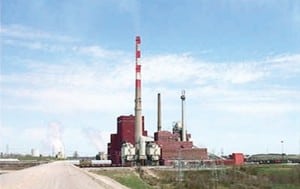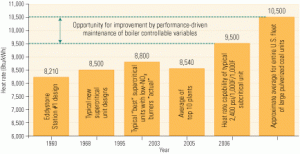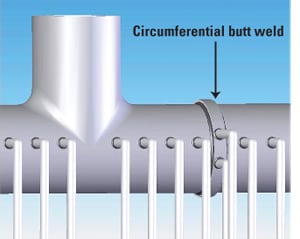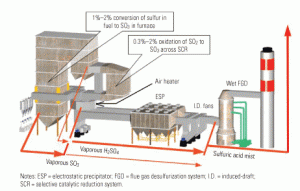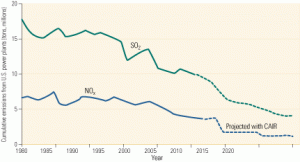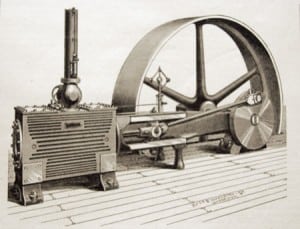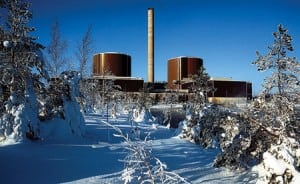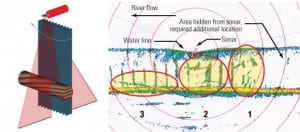Features
-
Instrumentation & Controls
Innovative boiler master design improves system response
A quick and nimble boiler distributed control system can end up moving at the speed of molasses in winter after a low-NOx retrofit. In one utility fleet, several units—despite being equipped with a modern DCS—were experiencing firing system time lags and degraded dynamic loading capability. Swinging steam pressures and opacity excursions were forcing operators to constantly remove the unit from the load dispatch. Read how a new boiler master design read the riot act to those unruly steam generators.
-
O&M
To optimize performance, begin at the pulverizers
A systematic, performance-driven maintenance program for optimizing combustion can achieve great results. The challenge for an O&M staff is deciding which proven strategy and tactics for reducing NOx and improving plant reliability to adapt and implement. The structured approach presented here has proven its worth at several plants that have wrestled with problems similar to yours.
-
O&M
Finding and fixing cracks in high-temperature headers
The welds on superheater and reheater headers are arguably the most stressed parts of a modern steam plant. For that reason, it’s surprising that they also may be the most under-inspected. Cracks are rare, but they can be repaired if found early. One plant avoided a long forced outage to replace a reheater outlet header by using the correct condition assessments and welding techniques.
-
O&M
SO3’s impacts on plant O&M: Part II
Part I of this three-part series (POWER, October 2006) explored the negative impacts of sulfur trioxide (SO3) on the operation and maintenance of back-end plant equipment. In this issue, we list and quantify the likely and potential benefits of limiting the concentration of SO3 in flue gas to 3 ppm at the entrance to the air heater. Part III—to appear in the April 2007 issue—will describe the characteristics of an optimal SO3 removal technology and present the technical details and operating experience of one patented process that has worked successfully at a half-dozen plants for up to three years.
-
Coal
Sealing abandoned mines with treated flyash kills two birds with one stone
Environmentally benign disposal of coal combustion products/by-products (CCPs) such as flyash and bottom ash has been a problem since the first coal-fired power plant went on-line. In recent years, ways have been developed to recycle CCPs into useful commercial products like bricks and roadbase. This article describes an innovative State of Maryland program that is putting CCPs to yet another use: stabilizing abandoned mines to permanently sequester acids and harmful metals.
-
Coal
NOx, SO3 in the spotlight at NETL’s 2006 Environmental Controls Conference
As emissions caps drop, technological solutions must become increasingly effective and efficient. Researchers, equipment vendors, and plant operators are exploring alternatives to SCR and SNCR, with a view to reducing the overall costs of NOx reduction. They’ve also achieved 95% to 99% removal of SO3, with no visible plume opacity.
-
News
This month in POWER . . .
February 1885 The cover story examined the latest in reciprocating engine technology: the Greene automatic cut-off engine (Figure 1). Here is how the editors described it: "The engine has a girder frame; guides case separate and dowelled and bolted to the bed plate; four-part main boxes; Porter governor. There are two steam and two exhaust […]
-
Nuclear
Tow nuclear power I&C out of the "digital ditch"
One expert has called it the "digital delta"—the seemingly endless challenges in refurbishing U.S. nuclear plants with digital instrumentation and controls. But it appears more like a deep ditch, where even those seeking to license new reactors could get stuck. Here’s the latest on the issues, experience, and results—plus recommendations for getting the industry out of the mud and back on the road.
-
O&M
Advanced sonar revolutionizes underwater structure inspections
Ongoing maintenance is critical to the performance and longevity of underwater structures such as cooling water intake tunnels. Commercial divers or robotic vehicles can do the needed inspections, but such manual methods require a costly plant shutdown and provide only qualitative results. ASI Group Ltd. has designed and built an advanced, dual-axis sonar system that works in fast-moving water and can deliver quantitative data about the extent and location of debris buildup on submerged assets.
-
Business
Put the dynamics of the workforce supply chain to work for you
A healthy and productive workforce is one that has been thoughtfully recruited and properly trained. Understanding the role and relationships of those and other attributes in the overall workforce supply chain is an essential management function. Here’s a roadmap for your consideration.

